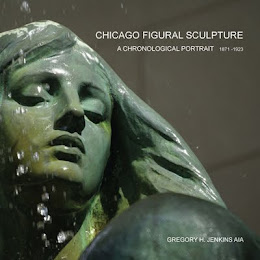Monday, July 27, 2009
GONE FISHIN'
Notes to self: Research the humoresques at Willoughby Tower to see if they might have something in common at 203 North Wabash. Find original floor plans to compare the progression of atria, elevators, and street access between the Rookery, Masonic Temple, Railway Exchange, Insurance Exchange, People's Gas.
The vacation pic is posted at Chicago Sculpture in the Loop.
Sunday, July 26, 2009
THE INSURANCE EXCHANGE. Thoughts on Style
I grew up in a pre-mid-century modern house, whose spare style was a statement of available materials and capital. In the fifties I watched with envy as the neighbors built their wooden house with sloped roofs, plate glass, and egalitarian bathrooms. In the sixties I saw Mies birth Mies Modern as he gutted a block of the loop. And tried to compete with the new Miami Beach Modern apartments on Lake Shore Drive for hearts and minds. I went to school in a Bauhaus inspired studio, learned of Corbu, the Wiener Werkhaus and the Fagus Works. Friends interned at TAC and came home wrapped in Marrimekko. "Total Scope with Grope, " they chanted (stoned out of their minds). My first apartment (seventies modern) had plastic furniture, an arc lamp, celery shag carpet, and a Macrame plant hanger. My cigarettes balanced on a Warren Platner ash tray. I participated in Post Modernisim (though the effect was somewhat diluted by the strip center building type that had become my specialty.) I've seen the granite and stainless elegance of nineties modern. The computer inspired millenial modern return-of-the-curve. And finally, (thank heaven) the come-to-Jesus, this-is-it, the-final-real-and-forever modern of the new age. Sensible. Sustainable. And nine-eleven secure. Designed by architects with head shots and windblown hair, and sales gigs ranging from "Magic Carpets" to "Deconstructivism".
Now, don't get me wrong. I can identify and relate to real masterworks of every decade of twentieth century architecture. (And in some future post I'll describe how Richard Meier's work in New Harmony, Indiana fundamentally changed my own work and way of thinking.)
But there is one thread of modernity that persists and repeats. It is the belief that "This time, we've got it right." "This time its real, lasting, permanent" There is an odor of infallibility. An arrogance that allows the destruction of even the finest expressions of generations now passed. Below is the "elegant transformation" of the Insurance Exchange. The original building was designed by Peirce Anderson in 1911. I forget who did the 1995 remodeling.




.
The original space was a dead ringer for the Atrium at the Railway Exchange (Daniel Burnham, 1904), though larger and more finely detailed. These days, there is a CAF Daniel Burnham Exhibit at the Railway Exchange, that is well worth seeing. The model of Chicago is spectacular. But take a look, too, at the skylight, the ironwork, the light fixtures, the balustrades. And consider the weight of loss and gain.
Wednesday, July 22, 2009
ARCHITECTURAL CRITICISM. Personal Responsibility



I think that those of us interested in Architecture need to remember that what surrounds us is not just an expression of effete style. To be criticized with a roll of the eye and a click of the very educated tongue -- to be dismissed because it is loved. It is a reflection of men (scroll down to that picture of Daniel Burnham as a teenager) and place and history. It is also a reflection of aspiration. And we need to remember this and talk about it and photograph it and share it as loudly and as often as we can. So when the time comes, as it apparently has, for Michael Reese, everyone would already know Walter Gropius and Peter Behrens and that mid-century modern was born in dreams already then 30 years old and that we were about to lose a piece of something irreparable. And every person whoever drank from the Rosenberg Fountain would, each day, know that Hebe (who holds the secret of eternal youth) is directly connected to those whose inspiration built a once great institution.
Sunday, July 19, 2009
ARCHITECTURAL CRITICISM. Chicago Style. Hold the Ketchup.
Root's ROOKERY "good" ..................................Burnham's PEOPLE'S "bad"..........................
Now I appreciate interesting ornament as much as the next guy. And Sullivan's is good. But if its MY birthday, I kinda think that the cake should be for me. And this year, its Dan's. JZHEEEZ. PLEASE.
On the other hand, if you want to talk "POMPOUS" - and I can talk "POMPOUS" - look to Sullivan's doo-dads at the top of the Gage Building. If you want talk "POMPOUS," let's talk about Zaha Hadid in Millenium Park. Ooops. Becker and I agree on that one. And one thing more on which we can all agree -- no one can match the consistently incisive writing in Lynn Becker's ArchitectureChicago Plus'. And that for the most part, "Odd Way", after all, is a broad ranging , truly insightful piece. And "Highly Recommended". Except for the areas in which I disagree. :-)
Thursday, July 16, 2009
Friday, July 10, 2009
LaSALLE STREET. North from Jackson Blvd. A glimpse of the past

Original Ornament. The Rookery. John Wellborn Root. 1885
.
William Peirce Anderson (who knew Daniel Burnham), Architect of the buildings that flank me as I look north to the Rookery, would surely have regretted not having met Burnham's first partner, John Root. Something never understood is how Root's expression of Chicago School Architecture passed so completely from Daniel's vocabularly.
But in the longer run, even that matters little. For those near to him, the "Plan" or even the "Style" was always secondary to Daniel Burnham, the man. For Anderson. Even for Ed Bennett.
Anderson knew Daniel well before that "Plan." Before Daniel became gout ridden, overweight "Uncle Dan," Friend of Presidents. Before the legend of his accomplishments over- shadowed the power of the man himself. For the 13 years he worked for him and then for next 14 years, as he, literally, built The Vision, Peirce Anderson's ever present mentor and inspiration remained Daniel Burnham. It is possible that Daniel's wife Margaret showed Peirce the photograph, below, taken when Daniel was 19. And this is how Anderson might like to remember him. At the beginning. All determination and energy.
.
Monday, July 6, 2009
LASALLE STREET. Fraternal Twins




This corner has made me rethink the value of order. Of symmetry. Of the variations allowable within seeming duplicates and implied order. Would these two buildings be better if they perfectly aligned? I think not. Both Ionic? No. Could just one of Mestrovic's Indians (just up the street) guard Grant Park? Of course not. Would exact duplicates weaken the power of their apparent symmetry? Hmm. Spearman, Bowman, Merchants Bank and Fed.
Staring at the rendered aerial view of Daniel Burnham's 1909 Plan for Chicago (for the gazillionth time) I again notice that the Randolph Street Pier is not exactly the same shape as the Pier Planned for 12th Street. That the Chicago River curves and splits and plays in counterpoint to the gridded streets. Remember that the Field Museum is slightly off-angle from Soldier Field. And consider the possibility that the Beaux Arts tradition in Chicago could be significantly more nuanced than I had previously considered.
.
Credits are due for use of the image above, of course, to Daniel Burnham.
Wednesday, July 1, 2009
LaSALLE STREET. 1924. At Jackson
Eighty years and the changes they've held, have mellowed the corner of LaSalle and Jackson. We see what we expect to see. Have always seen. But when the Board of Trade was constructed at the end of LaSalle Street, flanked by the existing classicism of the Federal Reserve Bank of Chicago and the Illinois Merchant's Bank, it was a violent statement of modernity. A stylized expression of verticality, and height, leaving its two classical "framers" at street level. Beneath the tallest building in Chicago. A title to keep until 1965. (See previous post.)
Blame it on the kids.
Graham, Anderson, Probst and White, Architects of the Merchants Bank and the Federal Reserve, not only continued Daniel Burnham's legacy of Classicism that won the Chicago World's Fair, they continued the almost unstoppably successful corporate culture that serves as a model of organization for architects today. They literally carried Daniel Burnham to the next generation. Peirce Anderson's dedication played no small part in this accomplishment. But time has a way of creeping up on us. The symmetrical porticoes of LaSalle Street were already "on their way out" at their time of completion. A generation late.
In 1923, William Holabird, revered, accomplished Chicago School partner at Holabird and Roche was dead. (See Chicago Sculpture in the Loop for recent developments at the Marquette Building.) In early 1924 Anderson died of cancer. It was time for John Holabird and John Root ("the kids"), architects of the Palmolive Building and 333 North Michigan to take center stage, unopposed, with a small assist from the 1924 Zoning Ordinance that allowed the Board of Trade to rise 605 feet above the street below.
A remarkable accomplishment. But the next few posts will belong to Peirce Anderson. We'll give the future to Holabird and Root.
Below are details of the Brass Marquis that stands in front of the Illinois Merchants Bank (completed 1924). Think nothing of the Great War. The Panic. The cancer. The astonishing growth of density within an already dense City. Think nothing of the passing of a generation that knew the Fire and the Fair. Or the Depression to come. Just - look at this brass.




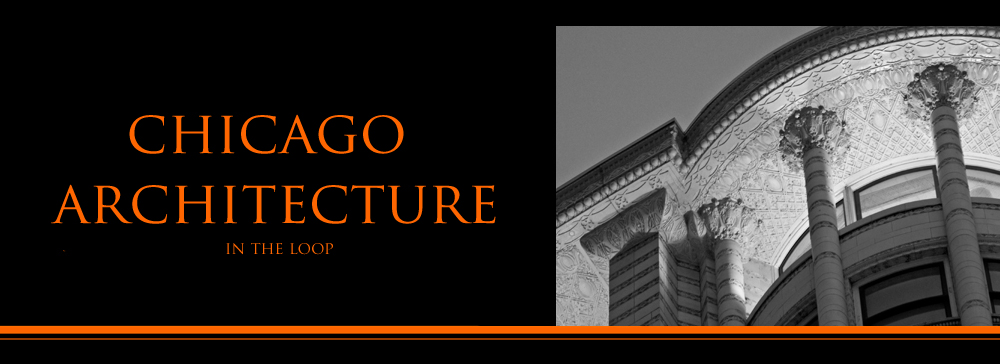







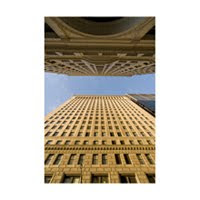

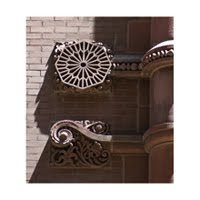

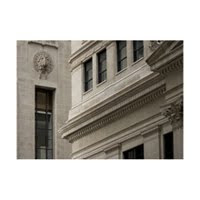
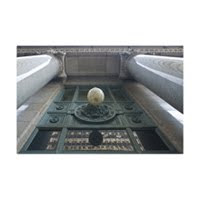
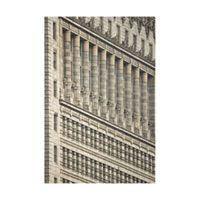




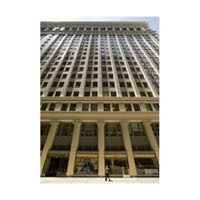
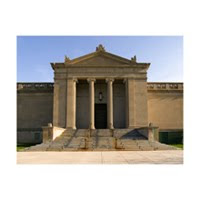
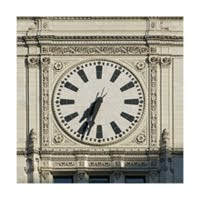

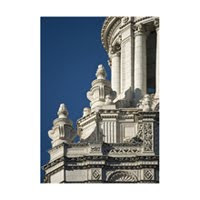

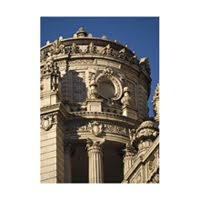


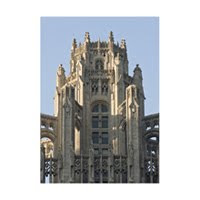
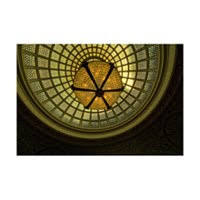



 .
.



















